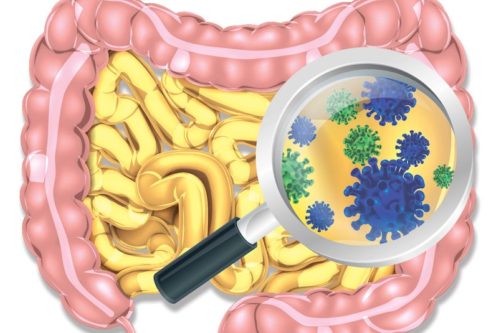Your gastrointestinal tract or digestive tract consists of the organs through which food passes between mouth & anus. These organs include mouth, esophagus, small intestine, large intestine & stomach. The purpose of the digestive tract is to digest & breakdown food, absorb nutrients & excrete waste products. Within our digestive tract, there are more than 100 trillion microorganisms which include bacteria, fungi, viruses & protozoa. There are several types of bacteria & microorganisms that live in/colonize our digestive tract. A lot of these have co-evolved with humans, are harmless or rather even beneficial to our health. These are called commensals. Some types of bacteria & microorganisms are harmful & can cause damage to our cells. These are called pathogens. The composition of our gut microbiome consists of various bacteria, fungi & viruses (both harmful & beneficial) and impacts our immunity function, digestive health, inflammation, metabolism & even our behaviour.
As mentioned above, some types of microorganisms are beneficial for our health. For example, the human body provides bacteria with nutrients & in return such bacteria can help with functions such as production of Vitamins & support of human immune responses. Changes in composition of gut microbiota can impact activity of these important & beneficial functions.
Benefits of these gut microbiome
Bacteria within our gut, especially in the large intestine help in breakdown of carbohydrates & fibre from our diet. Various gut bacteria make enzymes that ferment complex carbohydrates such as starch, thereby making key molecules – Short Chain Fatty Acids (SCFA).
SCFA provides an important source of energy for human cells within the large intestine. Besides, SCFA also influences metabolism of fat & carbohydrates (sugar), regular immune functions & changes in the pattern of inflammation. Our gut bacteria has the ability to make various essential vitamins such as Vitamin K, Vitamin B12, Vitamin B9 & Vitamin B2.
The inside walls of our intestine are lined with a layer of cells known as intestinal epithelium. This layer helps in absorption of nutrients & water & also act as a protective physical barrier against pathogens (harmful bacteria) inside the intestinal lumen.
One of the most important functions of gut microbiota is to support & stimulate the immune system which can help protect against infection. Our intestines have specialised tissues known as GALT, Gut Associated Lymphoid tissue, which are designed to mount an immunity response & fight off pathogens
Both commensals & pathogens produce unique patterns of molecules that are different from human cells. They have individual molecular signatures known as MAMP, microbe associated molecular patterns. These MAMP(s) on our gut bacteria are recognised by cells in our intestinal lining which have specialised receptors known as pattern recognition receptors (PRP). When PRP(s) are activated, they stimulate & drive various immune responses such as recruitment of while blood cells & release of antibodies. By stimulating these hormone responses, gut microbiomes help the digestive tract protect against antibodies. Such responses also prevent the gut from being colonized by harmful bacteria.
Let us talk about inflammation now, which is one of the impacts of presence of pathogens or change in composition of gut microbiota. Inflammation is the body’s protective response to injury which includes bacterial infection, toxins & other harmful stimuli. Although short term inflammation is useful in clearing harmful stimuli, chronic inflammation can cause damage to our cells. Excessive inflammation can damage cell lining of the stomach, intestine & structure of the digestive tract. This may cause digestive discomfort, issues with absorption of nutrients & alter bowel movements. Infact chronic inflammation is a component of the inflammatory bowel movement disease.
Changes in gut microbiota composition impact inflammation of the digestive tract. As shared above, our gut bacteria stimulates our immune system & helps our body to fight against pathogens – harmful bacteria, fight off infection & prevent inflammation. Some types of bacteria release substances that help in suppressing the inflammation.
On the flip side, gut bacteria is also capable of stimulating an excessive immune system response giving rise to inflammation & damaging cells of the digestive tract. Besides, pathogens can cause infection of the digestive tract, resulting in an inflammatory response. The balance between fighting pathogens & excessive inflammation is impacted by composition of gut microbiota. Reduced diversity of gut bacteria, too much or too little of certain bacteria can cause excessive inflammation.
NOD2, Nucleotide-binding oligomerization domain-containing protein 2, is a pattern recognition receptor which recognizes a unique molecular signature (MAMP) produced by certain bacteria. When NOD2 recognises unique molecular signatures of bacteria, it gets activated & coordinates production of various bactericidal substances that destroy & neutralise the bacteria. These bactericidal substances are referred to as antimicrobial peptides (AMP) & include enzymes & other protective proteins. By stimulating production of these AMPs, NOD2 protects the intestinal lining from being invaded & attacked by pathogens. Therefore NOD2 acts to protect against the inflammation of the intestinal wall. NOD2 ensures composition of gut microbiota is kept in balance thereby reducing the chances of inflammation.
NOD2 protein is encoded by NOD2 gene. Many of the NOD2 gene variants can lead to reduced function of NOD2 which in turn leads to impaired function of AMP. This allows pathogens to penetrate into the inner mucus layer & intestinal lining, triggering inflammation. This also causes imbalances in composition of microbiota.
Discover your personal traits & learn about your specific genetic predisposition to inflammation. By subscribing to our personalised fitness programs, you will not only receive information about genetic response to various aspects of nutrition & fitness but also be coached by an international fitness coach who will cover both genetics powered nutrition & exercise aspects of the program that will help you maximise your fitness potential. Sign up here.
